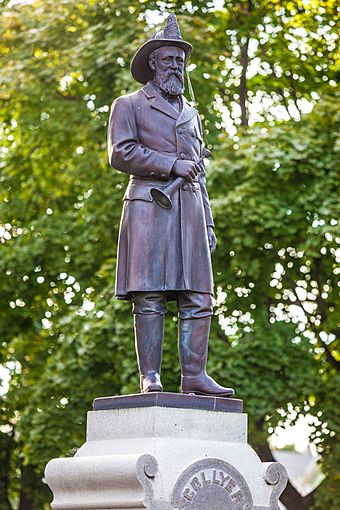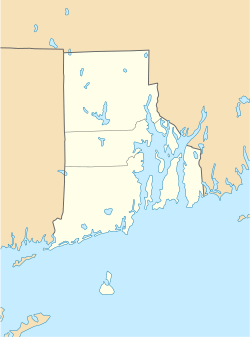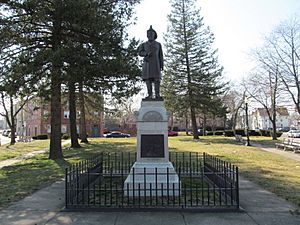Collyer Monument facts for kids
Quick facts for kids |
|
|
Collyer Monument
|
|

The monument in 2012
|
|
| Location | Pawtucket, Rhode Island |
|---|---|
| Built | 1890 |
| Architect | Dowler, Charles |
| MPS | Pawtucket MRA |
| NRHP reference No. | 83003808 |
| Added to NRHP | November 18, 1983 |
The Collyer Monument is a special statue located in Mineral Spring Park, Pawtucket, Rhode Island. It stands at the corner of Mineral Spring Avenue and Main Street. This monument was built in 1890 by a sculptor named Charles Parker Dowler. Its purpose is to honor Samuel Smith Collyer, who was a brave fire chief in Pawtucket and died while on duty.
The monument features a life-size bronze sculpture of Chief Collyer. This statue stands on top of a base made of Westerly granite. The granite base has a bronze plaque that shows a picture of the accident that caused his death. On the other side, there is an inscription. This memorial is an important example of the art and community spirit of that time. It shows how much local people cared about their town. The monument was added to the National Register of Historic Places in 1983.
Contents
Samuel Collyer: A Heroic Fire Chief
Samuel Smith Collyer was born on May 3, 1832, in Pawtucket, Rhode Island. After finishing school, he worked as a clerk at the Pawtucket Post Office. Later, he became a store clerk. He then worked as a machinist for about seven years. After that, he became a partner in his uncle's business.
When his uncle, Nathan S. Collyer, passed away in 1877, the business went to Nathan's wife. When she died in 1879, Samuel Collyer took control of the business. He managed it until his own death. Samuel also helped develop the Pawtucket Water Works, serving on its board. He was also active in local government, being a member of the Town Council of North Providence and serving as its president for three years.
From 1848 until he died, Collyer was involved with the fire departments of North Providence and Pawtucket. He became the Chief Engineer in 1874. In 1851, he married Ellen Whipple, and they had one daughter named Mary Collyer.
The Tragic Accident
The accident that took Samuel Collyer's life happened in July 1884. Chief Collyer was riding on Hose Carriage #1, responding to a fire alarm. The carriage hit a stone post at the corner of Mineral Spring and Lonsdale Avenue and tipped over. All six firefighters on the carriage were injured. Those on the step and seat were less seriously hurt. However, Chief Collyer, who was riding on the reel, was trapped underneath.
Collyer suffered a punctured lung and broken ribs. He survived for almost three weeks after the accident but sadly died from his injuries on July 27, 1884. People at the time said that his funeral service and procession were the biggest and most impressive in the town's history. Collyer's home, known as the Potter–Collyer House, was also listed on the National Register of Historic Places in 1983.
Design of the Monument
The Collyer Monument was built in 1890. The citizens of Pawtucket paid $2500 for it. The famous sculptor Charles Dowler was chosen to create a life-size bronze statue of Chief Collyer.
The bronze sculpture is about 7 feet (2.1 m) tall and 4.5 feet (1.4 m) wide. It shows Chief Collyer wearing his full firefighter's uniform and holding a trumpet. The base of the monument is 4.5 feet (1.4 m) wide and 8 feet (2.4 m) tall. It is made from Westerly granite from Westerly, Rhode Island.
A bronze plaque on the base shows the scene of the accident where Chief Collyer lost his life. His name is carved in an arch on the upper part of the statue's base. A metal picket fence surrounds the statue, and it was designed as part of the monument. On the back of the granite base, there is an inscription. It remembers Collyer, who died while serving his community. The inscription reads: "Erected To The Memory / Of / Samuel S. Collyer / Who Died July 27, 1884 / While In The Discharge / Of His Duty As / Chief Engineer Of The / Pawtucket / Fire Department / Born May 3, 1832."
Why the Monument is Important
The Collyer Monument is historically important for a few reasons. It is a great example of the type of large, impressive sculptures that American artists created in the late 1800s. It is also one of the first public sculptures in Pawtucket.
This monument shows the strong sense of community pride and artistic skill in Pawtucket. It was created to honor a local hero who was highly respected by everyone. The monument was dedicated on the last day of Pawtucket's Cotton Centenary Celebration in 1890. The Governor of Rhode Island at the time, John W. Davis, attended the dedication. The Collyer Monument was added to the National Register of Historic Places in 1983, recognizing its historical value.
See also
 In Spanish: Monumento a Collyer para niños
In Spanish: Monumento a Collyer para niños




